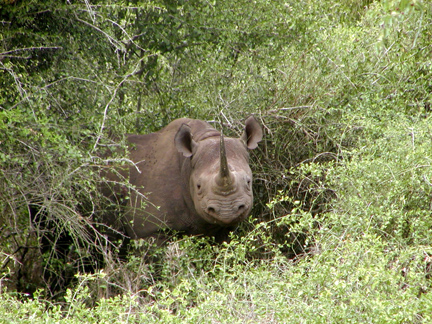The Multinational Species Conservation Acts play a significant role in the Division of International Conservation’s Wildlife Without Borders program. These Acts, enacted by the U.S. Congress, grant the Division the authority to establish the Multinational Species Conservation Funds and provide grants to projects benefiting elephants, rhinos, great apes and marine turtles in their natural habitats. The passage of the African Elephant Conservation Act of 1988 marks the first of these Multinational Acts. It was followed by the Rhino and Tiger Conservation Act of 1994, the Asian Elephant Conservation Act of 1997, the Great Ape Conservation Act of 2000, and most recently, the Marine Turtle Conservation Act of 2004.
The Multinational Species Conservation Fund Semipostal Stamp Act of 2009 was enacted as a way to provide the general public with a convenient way to contribute to the Multinational Species Conservation Funds. The Save the Vanishing Species Stamp was released in spring of 2011 and has generated over $1.3 million in proceeds that are equally divided among the five Conservation Funds.
African Elephant Conservation Act of 1988

Credit: Andrea Turkalo
Enacted in 1988 as an amendment to the Endangered Species Act, the African Elephant Conservation Act aims to protect African elephant species in the wild. A major threat to African elephants' survival comes from the illegal trade of ivory, which is derived from an elephant’s tusks. Additionally, many nations in Africa that have African elephant populations lack the necessary resources to protect, manage, and conserve their elephant populations. The act grants the Service the authority to establish the African Elephant Conservation Fund to provide funding for projects that benefit African elephant through research, conservation,and management of the species and its habitat.

Credit: Karl Stromayer/USFWS
Rhinoceros and Tiger Conservation Act of 1994
The Rhinoceros and Tiger Conservation Act of 1994 builds upon the Endangered Species Act and works to protect and conserve all subspecies of tigers and rhinos. These species are threatened by illegal trade of rhinoceros horns and tiger body parts. In compliance with the Convention on International Trade of Endangered Species of Fauna and Flora, the Rhino and Tiger Conservation Act aims to reduce the illegal trade of animal parts and promote projects that help manage and conserve these species in nations that both directly and indirectly affect these species. The Act grants the Service the authority to establish the Rhino and Tiger Conservation Fund to provide grants and funding for projects that help conserve these endangered species through research, species management, and education. Additionally, this Act prohibits the sale, importation, or
exportation of any products derived from rhino and tiger species across the U.S.
Asian Elephant Conservation Act of 1997

Credit: Jennifer Pastorini
In 1997, Congress passed the Asian Elephant Conservation Act in order to better comply with the Endangered Species Act, and fulfill United States’ responsibility as a member of the Convention on International Trade of Endangered Species of Fauna and Flora. Asian elephants face many threats including, habitat loss and fragmentation, human-elephant conflict, and poaching. In addition to these threats, there is a general lack of resources for Asian elephant conservation in Asian elephant range countries. In order to effectively address these issues, the Act establishes a cooperative method for the U.S., Asian elephant range countries, and the private sector to protect this species. The Act grants the Service the authority to establish the Asian Elephant Conservation Fund to provide funding for projects that protect and conserve the species through conservation and habitat management, research, improved law enforcement, conflict resolution initiatives, and community education and outreach.
Great Ape Conservation Act of 2000

Credit: Dirck Byler/ USFWS
The Great Ape Conservation Act of 2000 was established to protect and conserve the great ape species listed in both the Endangered Species Act and the Convention on International Trade of Endangered Species of Fauna and Flora. These species include the chimpanzee, gorilla, bonobo, orangutan, and gibbon. Currently these species face threats from habitat loss due to human encroachment and logging, as well as threats from population fragmentation, hunting for the rapidly expanding bushmeat trade, and disease transmission between humans and apes. Effective conservation of these species will require cooperative efforts between the U.S., countries within the range of great ape species, and the private sector. This Act grants the Service the authority to establish the Great Ape Conservation Fund to provide funding for projects that aim to conserve great apes throughlaw enforcement training, community initiatives, and other conservation efforts.
Marine Turtle Conservation Act of 2004

Credit: USFWS
The Marine Turtle Conservation Act of 2004 was established to support conservation projects that protect and conserve global marine turtle species. These species include loggerhead, green, olive ridley, leatherback, Kemp’s ridley, and hawksbill turtles. These turtles face major threats from illegal trade of meat, eggs, and shells, loss of nesting beaches due to infastructure development, and climate change. Additionally, this species is especially vulnerable to these threats because they are long-lived, mature late, and are highly migratory. Due to the global nature of marine turtles, Eeffective conservation of this species requires cooperation between the United States and countries that have marine turtle nesting beaches. The Act grants the Service the authority to establish the Marine Turtle Conservation Fund to provide funding for projects that conserve marine turtles through cooperative efforts to protect, restore, and manage nesting sites.

